
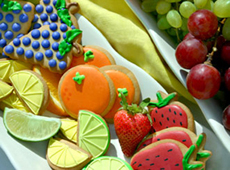 While waiting for the fresh fruits of summer to arrive, start with beautiful fruit cookies from Eleni’s.
|
 |
Gourmet News Archives
June 2005
6.27.05
A Guava A Day Keeps the Doctor Away. The U.S. Department of Agriculture has declared that the Florida guava ranks just below the antioxidant king, blueberry, in antioxidant content. Their research showed high antioxidant content in other Florida crops too, including star fruit, lychees, mango and papaya.
There are different species of guavas: some closely resemble lemons and limes on the outside. The interior fruit can be red, white, or yellow. Guavas have more vitamin C than oranges: a medium guava has 165 milligrams of C—one-third of the daily requirement.
Ceres guava juice has long been a foodie favorite, along with guava paste (delicious with cheese), guava ice cream and sorbet, guava jam and guava syrup. Fine guava products can be found at supermercados and specialty stores catering to the Latino market. Let’s hope this wonderful flavor goes more mainstream soon...perhaps following chai, chipotle and wasabi, recent “flavors of the year.”
|
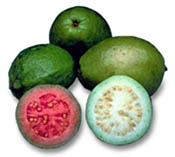 |
Fresh guavas (above) and guava products (below).
|
 |
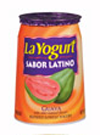 |
Guava is the tastiest of La Yogurt®’s Sabor Latino line, which has healthy live yogurt cultures (although a bit too much cornstarch thickening for our gourmet palates). Of the other high antioxidant flavors, Papaya was pleasant but too subtly flavored;Mango was a bit off. |
Go Nuts For A Healthy Heart. Louis Aronne, M.D., a leading obesity researcher who also has a private weight reduction practice in New York City, has long advocated almonds as part of a meal or snack for his patients. Now, new a new research study from the University of Toronto suggests that including almonds in a healthy diet is especially heart-healthy: in addition to lowering cholesterol, they reduce blood vessel inflammation by about the same level as taking a first-generation statin drug.
Foodies have long enjoyed almond accents in every course, from munching with with cocktails and cheese plates, baking into breads and muffins, mixing into cereals, salads, rice and vegetable dishes; coating or cooking with chicken and fish; and adding to candies, cookies and desserts in seemingly limitless ways. Now, almonds don an extra crown as a health food.
Click here for more information about the research study. For general information about almonds, visit AlmondsAreIn.com. |
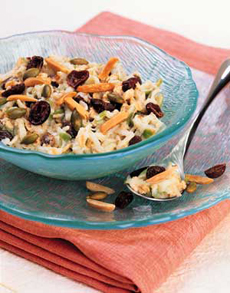 |
| Almond Muesli adapted by chef Graham Kerr for the Almond Board of California. © 2003 The Almond Board of California. |
Cool Down Organically. Most of the country has seen the first 90 degree days and we’re less than one week into summer. Honest Tea, the best selling brand of organic bottled iced tea, is at the ready with its new Honest Ade line of organic fruit drinks.
Sweetened with organic cane sugar rather than high fructose corn syrup (that’s one difference between commercial taste and quality taste) and 50 calories per serving, the first two flavors of the new line are Limeade and Cranberry Lemonade. Both are refreshing although we personally prefer a flavor profile with more of kick, i.e., more lime and more cranberry intensity. Still, we’re sure Honest Tea did their testing among their customer base, and the people have spoken. In its genre, it’s still the next best thing to homemade. |
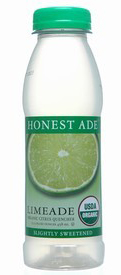 |
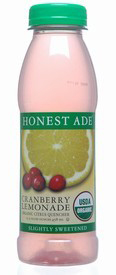 |
| Organic cool-down: Honest Tea’s new entries into the fruit drink market. |
6.20.05
Jammin’. ProductScan Online announced that mixed fruit, strawberry, apricot and raspberry are most popular flavors for new for jams and marmalades, based on new production introductions between April 2004 and March 2005. Indicating an increasingly sophisticated American palate, fig, lemon and plum, which did not make the top 10 in the prior year’s ranking, now on the radar screen. (In addition to lemon curd, look for lime and blood orange curds in your local specialty shops: they’re exquisite.)
Offset the Foie Gras. Yoplait Healthy Heart™ Yogurt from General Mills is the first U.S. yogurt to include cholesterol-lowering plant sterols. |
|
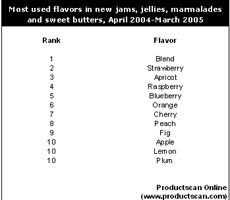 |
Two servings provide the same amount of plant sterols as 24 servings of broccoli or 44 medium apples. Available in the same 6-ounce cup a other Yoplait lines, Yoplait Healthy Heart is availalbe in Strawberry, Harvest Peach, Cherry Orchard, and Strawberry Banana.
|
|
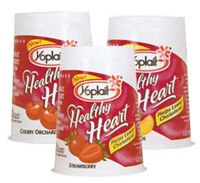 |
6.13.05
Pets Are Going Organic. American shoppers spent nearly $45.8 billion on natural and organic products in 2004, according to research published in the 24th Annual Market Overview in the June issue of The Natural Foods Merchandiser, the leading trade magazine serving the natural and organic products industry. In 2004, natural products sales increased 6.9 percent across all sales channels, including supermarkets, mass marketers, direct marketers and the Internet. Sales of organic products rose 14.6 percent in natural products stores.
As interest in low-carb diets waned, sales of organic baked goods rose 35 percent. Other fast-growing organic categories included meat, poultry and seafood, up 120 percent; coffee and cocoa, up 64 percent; and cookies, up 63 percent. Organic pet products grew 36 percent to $47 million.
Can it be true? Kids prefer fruit to chips? Nutritionists will tell you it’s chips America’s most popular snack. But according to a new survey by a leading market research firm, fresh fruit is the most popular snack among kids today. We haven’t seen the questionnaire so we don’t know exactly how the question was asked; but if it’s true, perhaps all the childhood obesity stories have had a beneficial effect. Skeptics that we are, we’re here to report news, so here’s what the research survey, conducted by the NPD Group, revealed: |
|
 |
All family members are eating better foods: sales of organic pet products grew 36% last year.
|
- Fresh fruit is the most popular snack among children ages 2 to 12.
- Yogurt is in second place with children ages 2 to 7, for boys 7 to 12 it’s potato chips; and for girls 7 to 12 it’s gum.
- Chocolate candy ranks in the top five for all children ages 2 to 12.
- Adults 18 to 54 prefer gum, chocolate, fresh fruit, breath or candy mints and ice cream.
The NPD Group tracks snack trends via online surveys where 750 people report on the snacks they ate the day before. Parents input the information for children under 7. With self-reporting in an anonymous environment (as opposed to a face-to-face interview), it may be easy for children to fudge the answers to what they think they should be saying.
According to Produce for Better Health Foundation, a non-profit group, children eat about 1.3 servings of fruit a day but should be having more than double that amount. Kids’ favorite fruits in order of preference are apples, bananas, grapes, peaches, oranges, berries, pears and pineapple.
6.6.05
The Return of the Webgrocer. An article in last week’s Wall Street Journal commented on the resurgence of online grocers. Despite the spectacular busts of dotcoms—Webvan alone ran through about $1 billion in capital before going bankrupt in 2001—and the generally low margins of the grocery business, some investors believe online grocers offer an attractive revenue model.
Targeting busy affluent families with interests in quality foods and specialty foods, FreshDirect, which launched in September 2002 in the metropolitan New York area, delivers the finest meats, produce, and gourmet foods. In addition to the basics, customers can order everything from tatsoi (a Japanese green with a bite similar to arugula and watercress) to a ready-to-cook, spinach stuffed salmon roast. Among the service’s hard-core evangelists are Manhattanites who need only take the elevator downstairs and walk to their corner market to shop. Yet, despite the convenience of location and long store hours, more than a quarter of a million New Yorkers have bought groceries from FreshDirect. The average receipt is $110; and in the first quarter of 2005, the company had $40 million in sales. The company is looking at expanding to cities with similar characteristics as New York: high Internet use, population density and wealthy residents.
Better management and understanding of the industry has made the difference between Fresh Direct and over-ambitious dotcom-era online grocers like Webvan, Streamline and HomeRuns. They had their fans too; but flush with dotcom cash, poured vast sums of it into costly warehouses and distribution networks that the low-profit-margin grocery business couldn’t support. |
|
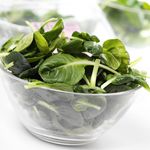 |
| Tatsoi from Fresh Direct |
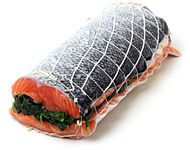 |
| Spinach stuffed salmon roast from Fresh Direct |
Over the past three years, the online segment has been bouncing back. MyWebGrocer, which provides online shopping services for 60 different grocery retailers, says the number of its supermarket clients has risen 30% in the past year. Peapod, a unit of supermarket giant Royal Ahold NV, reports 25% more consumers this year than last year. Safeway.com, the online grocery unit of Safeway Inc., launched in the Phoenix area in March and rolled out to six West Coast metropolitan areas. Other contenders in the space include Simondelivers.com and the re-launched Homegrocer.com.
In addition to saving regular shopping lists and bookmarking favorites for fast re-ordering, the online grocers continue to add convenient new services, from pharmacy refills to satellite navigation systems that alert customers when the delivery truck is close. As time to drive and shop gets scarcer, and order minimums and delivery fees become an insignificant parts of the equation, look for positive word of mouth and other incentives to make an online trier out of you. After all, when you wake up in the middle of the night realizing that you’ve forgotten the crown roast for that evening’s dinner party, all you have to do is log on, point, click, and go back to sleep—problem solved.
Lifestyle Direct Direct, Inc. All rights reserved. Images are the copyright of their respective owners.

|


 While waiting for the fresh fruits of summer to arrive, start with beautiful fruit cookies from
While waiting for the fresh fruits of summer to arrive, start with beautiful fruit cookies from 









